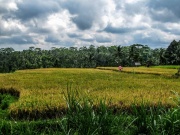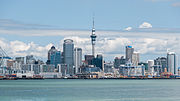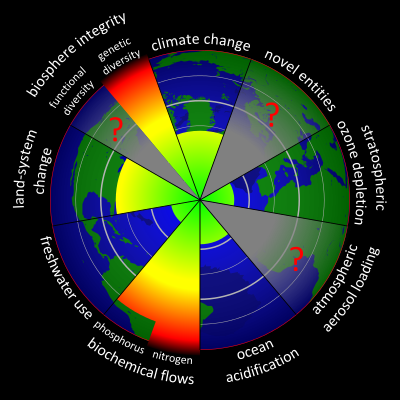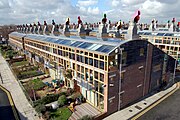Sustainable futures/SPS/Learning
Micro course : Strategic planning for success
Whatever outcome you’re focused on creating - be it a building, a product, a service or a community - great design ideas are driven by starting with the end in mind. So, defining what ultimate success looks like is fundamental to all good planning processes. In this micro course you’ll learn how to develop a clear and compelling vision that integrates a serious a smart approach to sustainable practice, and that can serve as a future reference point for setting strategy and developing creative solutions.
Contents
- 1 SESSION #1 - Developing a strong vision
- 2 SESSION #2 - Backcasting from sustainability principles
- 3 SESSION #3 - Framing the right strategic goals
SESSION #1 - Developing a strong vision
Objectives
- Understand what a vision is, and its critical importance to strategic planning processes
- Learn the characteristics and qualities of a compelling, inspiring and powerful vision
Video Signpost
Steve / Simon / Alexa? Key messages: Great leaders inspire others to act by presenting a powerful vision Analogy / metaphor - going on an ambitious trek. Someone needs to know where the team is going, and inspire them to keep going even when the going gets tough (examples, Shackleton, Scott, Martin Luther King) A clear vision creates the hook from which to hang strategies and creative solutions to achieve the goal.
Introduction
Great leaders inspire others to take action. What these leaders do is paint a picture of a future outcome and influence others to join in the effort to achieve that ambitious result. Vision statements are widely used by all sorts of organisations to frame strategic plans; yet they are often mundane, uninspiring and bland. As a result, the teams involved struggle to understand how their work can contribute to achieving the desired outcome, or what is required to change.
What is a vision, and why is it so important
Human’s are inherently strategic at the individual level, and regularly work towards a personal vision of the future. A vision, in this sense, is a picture of the future that you want to bring about. At the personal level this might be the sort of place you want to live, gaining your ideal job, or imagining your ideal garden.
At the organisational level, a vision is a powerful way of explaining the future that the organisation is working towards. For example, on 25th May 1961 President John F. Kennedy announced that before the end of the decade the USA would send a man safely to the moon. In 1969, that goal was achieved. As another example, the original Microsoft vision developed by Bill Gates and Paul Allen was “a computer on every desk and in every home”.
In the sustainability context, sustainability pioneer Interface has its framed its vision alongside its Mission Zero commitment, “To be the first company that, by its deeds, shows the entire industrial world what sustainability is in all its dimensions: People, process, product, place and profits — by 2020 — and in doing so we will become restorative through the power of influence.” This vision has inspired the people at Interface since 1995 and helped shaped the company’s achievements that make it one of the most respected and recognised sustainability leaders in the world.
An organisational vision provides the frame for a strategic planning process, and should reflect what real success looks like within the systems that the organisation operates. The vision then begs the question, what goals do we need to achieve in order to bring this vision into reality? In turn these strategic goals inform action planning, and what ultimately gets done.
The qualities and characteristics of a compelling and powerful vision
There is a wealth of debate and discussion about what qualities and characteristics make for a powerful and compelling vision. Perhaps much as to do with the personalities who are advocating and communicating the vision. And the Simon Sinek video above explains how, as a matter of human biology, visions might be developed to inspire action.
Considering what has worked well in for others is helpful and provides a useful guide. Dr. John Kotter, regarded by many as the modern authority on leadership and change. The list below is adapted from Dr. Kotter’s paper called Leading Change: Why Transformation Efforts Fail, and puts forward the following guidance for creating an effective vision statement:
- Desirable: Appeals to the long-term interests of employees, customers, owners and others who have a stake in the organisation
- Focused: Clear enough to provide guidance in decision-making
- Flexible: General enough to allow individual initiative and alternative responses in light of changing conditions
- Communicable: Easy to communicate in just a few minutes
- Imaginable: Conveys a picture of what the future could look like
- Feasible: Comprises realistic, attainable (though challenging) goals
- Describes a sustainable outcome: addresses all the organisation’s main sustainability challenges and opportunities
References
- Start with why -- how great leaders inspire action | Simon Sinek | TEDxPugetSound. Retrieved on 29th January 2015 from https://www.youtube.com/watch?v=u4ZoJKF_VuA.
- Interface homepage. Retrieved on 29th January 2015 from http://www.interfaceglobal.com/default.aspx
- Interface’s values are our guiding principles. Retrieved on 29th January 2015 from http://www.interfaceglobal.com/company/mission-vision.aspx.
- Dr. John Kotter. Leading Change: Why Transformation Efforts Fail. Harvard Business Review, March - April 1995, 95204. Retrieved on 29th January 2015 from http://www.sykehusapoteket.no/Upload/Topplederprogrammet/Litteratur/2.1%20Leading%20Change%20-%20Why%20Transformation%20Efforts%20Fail%20by%20JP%20Kotter.pdf
Additional Resources
Video (04:33): Dr. John Kotter: How to create a powerful vision for change. Retrieved on 29th January 2015 from https://www.youtube.com/watch?v=yA1a0khcuKo.
SESSION #2 - Backcasting from sustainability principles
Objectives
- Understand the benefits and advantages of backcasting
- Learn how to frame a vision of success using the Natural Step’s four sustainability principles
Video Signpost
Steve / Simon / Alexa? Key messages: Simple example of backcasting at a personal level - why it works! Refer to ABCD and backcasting slides to build understanding Explain the powerful advantage of backcasting from principles, as opposed to scenario planning - Analogy = Game of chess (dynamic and strategic) vs Jigsaw puzzle
Introduction
Decision-makers often talk about forecasting. They use information from the past to predict what will happen in the future - it’s like driving forwards in your car using only your rear-view mirror to see ahead.
From a sustainability perspective, we know there are past and current practices that do not fit with the reality of our ecological and biological setting. Perpetuating those practices will not help solve our challenge. Backcasting, on the other hand, assumes that the future is ours to create. By deciding what future we really want, we can design our plans and actions to create that future, rather than a future situation that is determined by what has happened in the past.
Backcasting explained
Forecasting assumes that current trends and demand patterns will continue into the future. Because plans are then made to meet and cope with this future, actions tend to turn the prediction into reality.
For example, a government agency might look at data for the growth in road traffic. Using that growth rate, the decision-makers might reach the conclusion to predict a future increase of 50% over the next 10 years. This conclusion then leads to the decision to build more capacity for the road network, to meet the predicted demand. But, what if - instead - the government agency set a goal of reducing road traffic by 20% and used that goal to shape its policy and decisions. What might the different outcome be?
Backcasting is a more creative way of shaping the future. It’s about beginning with the desired end firmly in mind. It allows us to decide what we want the future to look like, and then to implement plans, decisions and actions that are designed to bring that future about. It’s about actively shaping the future, rather than simply allowing the future to happen to us.
Backcasting from principles vs. Scenario planning
The Natural Step’s sustainability principles in the FSSD have been carefully designed for backcasting. Specifically, they are non-overlapping (that is, they are mutually exclusive, each covering a separate cause of unsustainability), and exhaustive (that is, together they cover all causes of unsustainability). And, to be used effectively for strategic planning using a backcasting methodology, the principles are also intentionally designed to be:
- Necessary: to define success
- Sufficient: to cover everything required for success
- General: to be equally applicable and useful for all sectors
- Concrete: to provide direction and inspiration for real action
- Distinct: by being mutually exclusive to enable robust monitoring of progress
Scenario planning might be compared to a jigsaw puzzle. There is a fixed and predetermined picture that you are creating. In the real world, the picture might be thought of as a view of the future that you are betting on, and thus working towards.
Backcasting from principles is more dynamic, and strategic. As opposed to a jigsaw puzzle, it might be likened to a game of chess. The principles defining success are fixed - checkmate, when your opponent can no longer move their king without being taken. How you reach that ultimate point is determined by strategy and actions that can adapt to changing circumstances, or how your opponent plays. Each move is evaluated against the goal of ultimate success. It allows predetermined strategies to be adapted and changed, depending on how well they are working, or to respond to a new situation.
References
- Video - Prof. Mohanbir Sawhney on backcasting. Retrieved on 29th January 2015 from https://www.youtube.com/watch?v=Rza6Xau1Wj0
- Holmberg, J. and Robèrt, K-H. (2000). Backcasting from non-overlapping sustainability principles – a framework for strategic planning. International Journal of Sustainable Development and World Ecology 7:291-308. Retrieved on 29th January 2015 from https://www.bth.se/ste/tmslm.nsf/attachments/Holmberg%20and%20Robert%202000%20-%20Backcasting%20from%20non-overlapping_pdf/$file/Holmberg%20and%20Robert%202000%20-%20Backcasting%20from%20non-overlapping.pdf.
Additional Resources
Journal article: Holmberg, J. - Backcasting: A Natural Step in Operationalising Sustainable Development. GMI 23 (Autumn 1998). Retrieved on 29th January 2015 from https://www.upc.edu/sostenible2015/menu2/Seminaris/Post_Seminari_STD/docs/holmberg_1998.pdf.
SESSION #3 - Framing the right strategic goals
Objectives
- Understand how strategic goals give life to the vision
- Learn how to frame strategic goals that address the right challenges and opportunities
- Learn about some common frameworks that suggest strategic priority areas for sustainable development
Video Signpost
Steve / Simon / Alexa? Key messages: In life and in business a lot of our activities these days are reactive. Yet, progress that is most satisfying and fulfilling usually relates to the big goals that we want to achieve. Framing these big, longer-term achievements with concise strategic goals help keep us focused, and enables better planning to keep us on track. Setting the right goals that describe ultimate success can also help inform new ideas and innovation that is the most effective way of achieving our ambitions. Example - Many businesses focus on setting targets that seek incremental improvements, like a 20% reduction in waste to landfill - for example. This tends to reinforce current practices, or tweak them, to find efficiencies. But, setting a goal of zero waste asks a much bigger question that can inspire people to look beyond business as usual to find systemic development that eliminates waste through design and re-design. This session focuses on what goals to set for organisations that are serious about sustainability, and how to frame them to make sure that all the right issues are covered.
Introduction
Sustainability goals are often vaguely described or expressed as targets for efficiency gains in waste, water, energy use and other operational issues. Setting the right goals is essential for guiding research, innovation and people’s efforts in a way that will most effectively and efficiently address sustainability risks and opportunities. This session explains how the right strategic goals can give life to an audacious and aspirational vision, like Interface’s vision of Mission Zero.
Strategic goals that give life to an aspirational vision
The vision for Auckland is “The world’s most liveable city”. The Auckland Plan then identifies seven high level objectives, or strategic outcomes, that cluster initiatives and activities aimed at making Auckland the world’s most liveable city. It’s an ambitious vision, stated very simply, that involves an incredibly complex web of activity.
Carpet manufacturer and sustainability pioneer Interface has framed its vision alongside its Mission Zero commitment, “To be the first company that, by its deeds, shows the entire industrial world what sustainability is in all its dimensions: People, process, product, place and profits — by 2020 — and in doing so we will become restorative through the power of influence.” This vision has inspired the people at Interface since 1995 and helped shaped the company’s achievements that make it one of the most respected and recognised sustainability leaders in the world.
Interface used the Natural Step framework to develop a sustainability strategy that could help focus the company’s efforts to achieve this ambitious vision. It comprised seven high-level goals that Ray Anderson often called the seven fronts of Mount Sustainability:
- Eliminate Waste: Eliminating all forms of waste in every area of the business
- Benign Emissions: Eliminating toxic substances from products, vehicles and facilities
- Renewable Energy: Operating facilities with renewable energy sources, solar, wind, landfill gas, biomass, low impact hydroelectric
- Closing the Loop: Redesigning processes and products to close the technical loop using recovered and bio-based materials
- Resource Efficient Transportation: Transporting people and products efficiently to reduce waste and emissions
- Care for People: Creating a culture that integrates sustainability principles and improves people lives and livelihoods
- Redesign Commerce: Creating a new business model that demonstrates and support the value of sustainability-based commerce
The real power and strength of these goals is that because they described ultimate success, as defined by a robust scientific understanding of sustainability, they have remained constant over time. This provides a stable basis for sustainability programmes and investment, and enables a consistent set of performance metrics.
Addressing key sustainability challenges and opportunities
The desired outcome of creating a strong sustainability vision and strategy is to define the parameters of success for how things will be in a sustainable future. The strategic goals should address all the current challenges that stand between the current reality and that ideal future. They should also enable all existing and foreseeable opportunities to be captured. This requires developing long-term objectives, outcomes or goals that can serve as a North Star or compass to navigate by.
In Step B of the ABCD process (covered above in Micro Course 2) you learnt how to understand the risks and opportunities posed by sustainability trends using the Funnel model; how to identify positive and negative sustainability impacts using the Natural Step’s four sustainability principles; and how to evaluate important relationships. An ideal set of strategic goals will cover all of the relevant issues identified from this Step B baseline assessment at the same time as defining what the ideal, long-term outcomes are.
A good way to identify a set of high-level strategic goals is to write all the individual challenges, opportunities and issues on post-it notes. You can then move and cluster the post-it notes into themes that make sense for the particular organisation or situation. For example, energy and fuel issues might cluster together under a goal relating to carbon neutrality; landfill waste and operational efficiencies might be clustered together under a zero waste goal; or, alternatively, where appropriate physical waste might relate to a goal focusing on closed loop production.
The North Star goals set by Nike to frame its Considered Design initiative are a good example of focused, business specific goals that address particular challenges and opportunities. The process behind setting those goals is covered in a case study, and you can find the final goals in Nike’s Corporate Responsibility Report here.
Generally, framing strategic goals is best done as a group activity with people who have a solid understanding of the issues and how an organisation works. The aim of the goals is to motivate people and inspire solutions to the challenges that the organisation wants to tackle; so there is no ‘one size fits all’ approach.
Strategic frameworks for sustainability
The Natural Step framework’s four sustainability principles allow people and organisations to audit and identify where their activities present sustainability challenges. This has been considered in detail above. The framework doesn’t prescribe any specific strategies or goals, but leaves that to the particular organisation to work out how best to set the goals that will, over time, enable compliance with the four basic principles in an economically viable way.
A number of other frameworks provide additional guidance on themes that a sustainability strategy might cover. This section outlines the most well known frameworks and points you towards online materials where you can consider them in more detail.
The Future Fit Business Benchmark
The Future Fit Business Benchmark is an open-source initiative being co-led by 3D Investment Foundation and The Natural Step Canada. It has the support of leading international sustainability practitioners like John Elkington and Bob Willard.
The Future Fit Business Benchmark was released in draft in 2014 for comments. It sets out a range of goals that businesses should aspire to if they are serious about sustainability and being future fit organisations. The work will develop in phase 3 of its evolution to identify a set of ideal measures and metrics that future fit organisations should monitor to show progress against the goals.
Planetary Boundaries framework
Planetary boundaries is the central concept in an Earth system framework proposed by a group of Earth system and environmental scientists led by Johan Rockström from the Stockholm Resilience Centre and Will Steffen from the Australian National University.In 2009, the group proposed a framework of “planetary boundaries” designed to define a “safe operating space for humanity” for the international community, including governments at all levels, international organizations, civil society, the scientific community and the private sector, as a precondition for sustainable development.
This framework is based on scientific research that indicates that since the Industrial Revolution, human actions have gradually become the main driver of global environmental change. The scientists assert that once human activity has passed certain thresholds or tipping points, defined as “9 planetary boundaries”, there is a risk of “irreversible and abrupt environmental change”.
Red: Beyond zone of uncertainty (high risk)
Yellow: In zone of uncertainty (increasing risk)
Green: Below boundary (safe)
Grey: Boundary not yet quantified
One Planet Living
One Planet Living is an initiative of Bioregional and its partners. The framework uses ecological footprinting and carbon footprinting as its headline indicators. It is based on ten guiding principles of sustainability as a framework.
The concept of One Planet Living builds on sustainability work carried out by Bioregional over the past few decades but specifically grew out of Bioregional’s work to build the BedZED eco-village in south London.
The 10 One Planet Living principles cover:
- Health and happiness
- Local and sustainable food
- Equity and local economy
- Sustainable materials
- Culture and community
- Sustainable transport
- Land use and wildlife
- Zero waste
- Sustainable water
- Zero carbon
Forum for the Future’s Five Capitals model
The Five Capitals Model provides a basis for understanding sustainability in terms of the economic concept of wealth creation or ‘capital’. Any organisation will use five types of capital to deliver its products or services. A sustainable organisation will maintain, and where possible enhance, these stocks of capital assets, rather than deplete or degrade them. The model allows business to broaden its understanding of financial sustainability by allowing business to consider how wider environmental and social issues can affect long-term profitability.
The Five Capitals Model is put forward to be used by organisations to develop a vision of what sustainability looks like for its own operations, products and services. The vision is developed by considering what an organisation needs to do in order to maximise the value of each capital. However, an organisation needs to consider the impact of its activities on each of the capitals in an integrated way in order to avoid ‘trade-offs’. Using the model in this way for decision-making can lead to more sustainable outcomes.
References
- Auckland Plan objectives. Retrieved on 11th March 2015 from http://www.aucklandcouncil.govt.nz/EN/planspoliciesprojects/plansstrategies/theaucklandplan/Pages/theaucklandplan.aspx?utm_source=shorturl&utm_medium=print&utm_campaign=Auckland%2BPlan
- Interface homepage. Retrieved on 11th March 2015 from http://www.interfaceglobal.com/default.aspx
- Interface Mission Zero. Retrieved on 11th March 2015 from http://www.interfaceglobal.com/default.aspx
- Nike North Star Chart. Retrieved on 10th Ocotber 2015 from http://www.nikebiz.com/crreport/content/charts/chart-5-2.php
- Nike case study - Retrieved on 11th March 2015 from http://www.thenaturalstep.org/sites/all/files/Nike%20Case%20Study_Jan2009.pdf
- Nike’s Corporate Responsibility Report - Retrieved on 11th March 2015 from http://www.nikebiz.com/crreport/content/pdf/documents/en-US/full-report.pdf
- ISL case study - Retrieved on 11th March 2015 from http://www.thenaturalstep.org/commitment-to-sustainability-drives-rapid-change-at-isl/
- ISL strategic goals - Retrieved on 11th March 2015 from http://islengineering.com/index.php?option=com_content&view=article&id=189&Itemid=136
- Future Fit Business Benchmark - Retrieved on 11th March 2015 from http://futurefitbusiness.org/resources/download/
- Planetary Boundaries framework - Retrieved on 11th March 2015 from http://www.stockholmresilience.org/21/research/research-programmes/planetary-boundaries.html
- Nine Planetary Boundaries retrieved on 10th October 2015 from http://www.stockholmresilience.org/21/research/research-programmes/planetary-boundaries/planetary-boundaries/about-the-research/the-nine-planetary-boundaries.html
- Journal article: Ny, H., MacDonald, J.P., Broman, G., Yamamoto, R. and Robèrt, K.-H. 2006. Sustainability Constraints as System Boundaries – an Approach to Making Life Cycle Management Strategic - Retrieved on 11th March 2015 from http://bth.diva-portal.org/smash/record.jsf?dswid=-9540&pid=diva2%3A835976&c=1&searchType=SIMPLE&language=en&query=Sustainability+Constraints+as+System+Boundaries&af=%5B%5D&aq=%5B%5B%5D%5D&aq2=%5B%5B%5D%5D&aqe=%5B%5D&noOfRows=50&sortOrder=author_sort_asc&onlyFullText=false&sf=all
- One Planet Living - Retrieved on 11th March 2015 from http://www.bioregional.com/oneplanetliving/
- WWW Rights of Earth - Retrieved on 11th March from assets.panda.org/downloads/r23_rights_of_earth.pdf
- Overview of the Five Capitals Model - Retrieved on 11th March 2015 from http://www.forumforthefuture.org/project/five-capitals/overview
- Detailed download for the Five Capitals Model - Retrieved on 11th March 2015 from https://www.forumforthefuture.org/sites/default/files/project/downloads/five-capitals-model.pdf.
Additional Resources
Full Interface case study - http://www.naturalstep.org/sites/all/files/case_study_interface.pdf Retrieved on 11th March 2015















